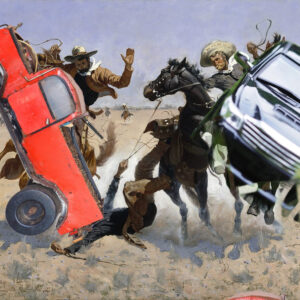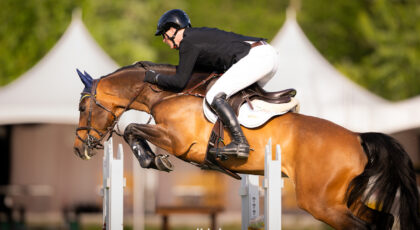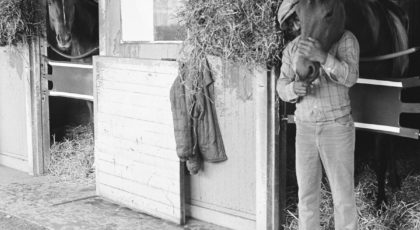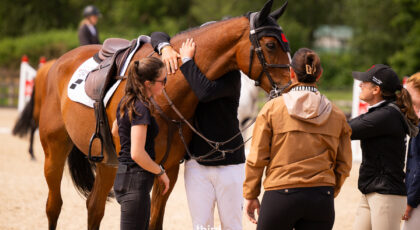In the past decade chiropractic work—for human, horse, and other animals—has been increasingly accepted by the mainstream as a viable means of easing or, in some cases, eradicating pain or limitation of movement. The key word here is chiropractic subluxation, which is essentially a joint that is not working properly. These rarely show up via X-ray and involve a number of behind-the-scenes players that mean subluxated joints can have a variety of symptoms.
Dr. Renee Tucker practiced veterinary medicine for five years before becoming certified in chiropractic work after discovering how it could help solve many “mystery lamenesses” and behavior problems in horses.
“A five-year-old, 17.2-hand Thoroughbred gelding named Ben continually got a subluxation in the right side of his neck, making it very difficult for him to bend to the right,” Dr. Tucker shares in her bestselling book “Where Does My Horse Hurt?“
“We had to adjust his neck once a month, which is really too often, especially for such a young horse. And every month, there was nothing else chiropractically wrong with him. His teeth were good and he had no history of injury…it took some time before I finally learned from the caretaker that Ben was always sticking his head and neck through the fence to eat. (Mind you, he’s out in a 10-acre pasture with plenty of grass. This proves that the grass really is greener on the other side of the fence!) Just because a horse sticks his head through a fence does not necessarily mean his neck will subluxate all the time. However, when he’s in this position and his best buddy comes up and bites him on the behind, he’s asking for trouble as he jerks his neck back through the rails to defend himself.”
In “Where Does My Horse Hurt?” Dr. Tucker shows us 27 simple body checkups that we can do to determine WHEN and WHERE your horse hurts, and if it makes sense to call a chiropractor.
If your horse…
Has a stiff neck or body
Is unable to bend his neck right or left
Has difficulty with collection or impulsion
Is unable to do “long-and-low” work
Braces on a rein
Goes wide on turns
Drops his shoulder on turns
Is reluctant to bend his body
Is stiff in the front end
Is uncomfortable with haltering or bridling
Has a ewe neck
…then he might have a subluxation in the neck (cervical) vertebrae, like Ben.
How to Check the Neck (Cervical) Vertebrae

©Ginger-Kathleen Coombs
As you go down the cervical spine, after the atlas there are five cervical vertebrae (numbered C2-C6) that can be felt. These are located on the side of the neck in the lower segment of the widest part of the neck. All the neck muscles are above these vertebrae. For a few minutes, practice feeling the spaces between the vertebrae: As you run your hand along them, you’ll feel a hard area (a vertebra) followed by a slight drop into a small soft spot (a joint). This is immediately followed by another vertebra.
Check each vertebra at the point where it has the greatest movement. In order to do this, the horse’s neck must be curved toward you, which eliminates some of its ability to move. This way you can isolate the vertebra you want to check. The horse’s head should be shifted over 1 to 2 feet while the neck curves, as if you are doing a partial carrot stretch. Place your fingers lightly under the halter to ask the horse to curve his neck to the side. It is important not to use force to pull the neck because that causes the neck muscles to tighten, which will interfere with the neck checkup.

©Ginger-Kathleen Coombs
Run your hand along the horse’s neck, and when you get a feel for where each vertebra is located, place the pisiform section of your hand on the center of an individual neck vertebra. Gently push down at approximately a 45-degree angle from the top of the neck. Your elbow will point upward to create this angle. Depending on your height—and the horse’s—you may need to use a step stool in order to be at the correct angle. As you push down, the vertebra should move down at least one inch. Use the amount of pressure that you would use to massage the top of your own forearm.

©Ginger-Kathleen Coombs
You are looking for a “bounce” to the bone as it moves downward: It should move down with your hand pressure and come back up (this is the “bounce”) when you release the pressure. If instead it feels as if your hand is pressing against an immovable rock, you are feeling a subluxation. This “rock” feeling is literally as if you’re pressing on solid bone, with no “give” at all. Be sure to check both sides of the neck. One side may feel perfectly “bouncy,” while the other side feels like rocks.
Another sign of a subluxation is when you find the horse is repeatedly sensitive to the area you are checking. When a subluxation indication is found, call your chiropractor.
∗∗∗

This excerpt from “Where Does My Horse Hurt?” by Dr. Renee Tucker is reprinted with permission from Trafalgar Square Books.

 February 2, 2017
February 2, 2017 


























